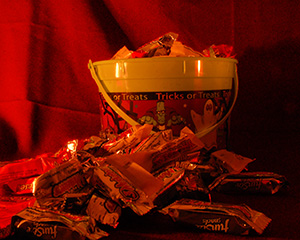
Trick-or-Treating That's Fun for Kids with Autism and Sensory Processing Disorders
 Halloween is a time of year for make-believe, candy apples and, of course, trick-or-treating, but some Halloween traditions aren’t for everyone. In fact, Halloween can be a stressful and demanding time for kids with Autism Spectrum Disorder (ASD) if they aren't prepared. Many Halloween festivities include strobe lights, fog machines, sound effects, and other sensory stimuli that can be overwhelming to individuals on the spectrum. So this year, prepare for potential sensory triggers, such as smells, sights, or crowds to help your child enjoy the holiday of boo, without the boo-hoo.
Halloween is a time of year for make-believe, candy apples and, of course, trick-or-treating, but some Halloween traditions aren’t for everyone. In fact, Halloween can be a stressful and demanding time for kids with Autism Spectrum Disorder (ASD) if they aren't prepared. Many Halloween festivities include strobe lights, fog machines, sound effects, and other sensory stimuli that can be overwhelming to individuals on the spectrum. So this year, prepare for potential sensory triggers, such as smells, sights, or crowds to help your child enjoy the holiday of boo, without the boo-hoo.
Prepare and Prime Visually
Social narratives, visuals, videos, and photos are all great tools to help prepare for trick-or-treating. Consider using a visual schedule for the evening events in a similar format that you use for other activities at home and at school.
The visual schedule should include when you plan to leave the house (i.e. after dinner), where you are going to trick-or-treat, and what may happen during and after. More than likely, you have an idea on how long you plan to trick-or-treat and the number of houses you plan to visit. Also, be sure to include as many steps as possible on what to do at each house.
It might be a good idea to visit the neighborhood or event ahead of time. This will allow you to plan for worst-case scenarios or sensory triggers before Halloween festivities.
If it’s not too confusing, you may also choose to practice common phrases used while trick-or-treating, such as "trick or treat" and “thank you.” And if a visual communication board is needed, be sure to include basic requests and terms that could potentially be used throughout the night. These terms include basic requests such as "I need help" and "I need to go to the bathroom" or even replies such as "yes" and "no."
Be Flexible
If "trick-or-treating" is a new and unfamiliar social situation for a child on the autism spectrum, it is important to be as flexible and realistic as possible throughout the night. It might even be a great idea to consider recruiting family members and friends to come along. Explain to everyone (including their parents) that they are helping the individual know how to "trick-or-treat" while having fun all at the same time.
The weather can also be a bit unpredictable for your Halloween activities, so it’s important to be ready for any scenario. If the weather causes a change of plans, prepare your child for the change through the use of visual aids or a narrative.
Another alternative to traditional trick-or-treating is to invite friends and family over for a memorable night of trick-or-treating in the comforts of your own home. Allow the kids to go from room to room for the same experience, minus the weather and other unpredictable social, communication and sensory issues that might occur.
Have Fun!
If multiple children are going trick-or-treating, bring a few favorite activities for your disinterested child to engage in while riding along throughout the night if they decide not to nactively trick-or-treat. It might also be a good idea to bring a change of clothes and snacks to keep the kids comfortable while waiting for everyone to finish trick-or-treating.
And don’t forget to check the labels and nutrition on all of the candy and treats. Some items could contain allergens or ingredients that don't agree with your child.
Remember, Halloween is meant to be fun. Be sure to take pictures of the event. These can be used to prepare visually for next year’s trick-or-treating adventure too.
Looking for other Halloween activites for you and your family? Find more here.






 “Streaming is both accessible and not accessible,” Evans said. “The streaming part itself is accessible, in that it allows me to make my own schedule, and I can work it around my disabilities. However, the inaccessible part is the demand for content creators to constantly be networking, attending events and continuously pushing out content. I cannot attend events, and if I can they’re incredible stressful, so all my work networking has basically been done online, which thankfully is becoming a more acceptable side of content creation.”
“Streaming is both accessible and not accessible,” Evans said. “The streaming part itself is accessible, in that it allows me to make my own schedule, and I can work it around my disabilities. However, the inaccessible part is the demand for content creators to constantly be networking, attending events and continuously pushing out content. I cannot attend events, and if I can they’re incredible stressful, so all my work networking has basically been done online, which thankfully is becoming a more acceptable side of content creation.” “I must say over the years it has become less and less accessible for me,” Martínez said. “SMA (Spinal Muscular Atrophy) causes strength, endurance and mobility loss as time passes. I can’t use a physical keyboard as I used to, so it’s been years now with an on-screen keyboard. Voice dictation doesn’t work well for me due to my voice being inconsistent, not to mention my accent. In English it can go from totally wrong to acceptable. In Spanish, my native language, it works better.”
“I must say over the years it has become less and less accessible for me,” Martínez said. “SMA (Spinal Muscular Atrophy) causes strength, endurance and mobility loss as time passes. I can’t use a physical keyboard as I used to, so it’s been years now with an on-screen keyboard. Voice dictation doesn’t work well for me due to my voice being inconsistent, not to mention my accent. In English it can go from totally wrong to acceptable. In Spanish, my native language, it works better.” “What drew me to consulting was the opportunity to leverage my unique perspective as both an able-bodied and disabled gamer to improve the gaming experience for others,” Lane said. “I can share the frustrations I’ve faced as a disabled gamer and use that knowledge to advocate for better accessibility features. Companies and studios that I work with go the extra mile to make sure I have everything I need to succeed.”
“What drew me to consulting was the opportunity to leverage my unique perspective as both an able-bodied and disabled gamer to improve the gaming experience for others,” Lane said. “I can share the frustrations I’ve faced as a disabled gamer and use that knowledge to advocate for better accessibility features. Companies and studios that I work with go the extra mile to make sure I have everything I need to succeed.”





Connect with us on social media